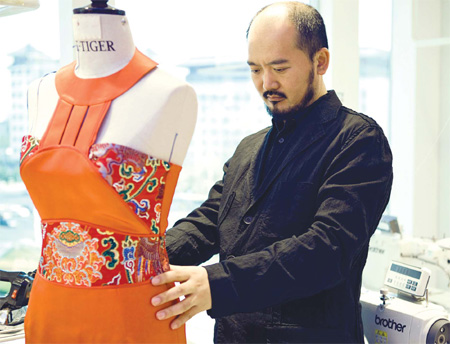Crouching tiger
Updated: 2011-03-25 10:23
By Xiao Xiangyi (China Daily European Weekly)
Fashion designer pioneers Chinese luxury brands
When President Hu Jintao visited the United States earlier this year, there was a flurry of promotional activity highlighting the best of China. Spearheading the campaign was a 60-second video aimed at promoting China's national image. It debuted on six huge screens in Times Square, New York, and featured the nation's best-known faces, such as Jackie Chan and Yao Ming.
 |
|
Zhang Zhifeng plans to build his NETIGER as an international luxury |
But there was another notable who is famed for resurrecting Chinese traditional handicrafts that were once reserved for royalty.
Zhang Zhifeng is a pioneer of Chinese luxury fashion and the veteran designer wants to build his NETIGER as an international luxury brand in China - in the same league as Louis Vuitton and Armani.
NETIGER is the leading Chinese haute couture brand for furs, evening gowns and wedding clothes and has studios scattered across France, Italy, Russia and the US.
Last year, a NETIGER dress, which featured patterns of peony flowers and phoenixes, was collected by the Capital Museum because of its seamless weaving techniques and the use of seven different ways of silk crafting.
Movie stars such as Gong Li, Zhang Ziyi and Fan Bingbing are regular wearers adding further glamour to the label.
The Chinese brand has even become a hit among European royalty with the Prince of Denmark, Joachim Holger Waldemar Christian, choosing a NETIGER evening gown for his fiance.
"We show esteem to our ancestors by exploring the endangered arts," Zhang says. "And our craftsmanship also adapts to the development of the fashion market."
Haute couture is very time-consuming and it can take two or three months to make just one suit, with prices varying from 50,000 yuan (5,378 euros) to 300,000 yuan.
The first haute couture "Phoenix Dress" using the Yunjin technique was made in 2006. Embroiderers spent 800 hours working on it.
On Oct 25 last year, NETIGER stole the show during China Fashion Week with a new interpretation of Qiang embroidery, which reflects the essence of the 6,000-year-old Qiang ethnic people and stands out with its bold, unconstrained and simple artistic style.
Zhang and his team have been to Sichuan, the home of the Qiang people, to better understand the techniques of embroiderers.
He says classical Qiang embroidery is passed on from generation to generation.
"Fashion and tradition are never a paradox," Zhang says. "I hope to arouse an awareness and appreciation of the endangered or rare traditional craftsmanship via my work."
To find out the fine details of different folk crafts, Zhang has searched through many museums, read scores of ancient books and has traveled to Japan to uncover the true authenticity of the subject.
To obtain high-grade silk, Zhang also raises silkworms at his own farm, which is located in mountain areas in East China's Zhejiang province.
"I didn't realize how wonderful Chinese culture is until I went abroad, just like a son will never know the warmth of home until he leaves his parents," Zhang recalls when asked about his original impulse to set up a Chinese luxury brand with traditional elements.
According to Zhang, China is the origin of Western luxury.
During the Han Dynasty (206 BC - AD 220), Chinese imperial envoy Zhang Qian took Chinese treasures, such as silk and tea, to the West via the Silk Road.
"In the Ming Dynasty (1368-1644), a china bowl was more expensive than a Louis Vuitton bag today," he says.
Zhang says many foreign veteran designers tell him they would love to visit China to discover exotic oriental elements that could be adopted into their designs.
"The development and prosperity of global civilization is based on mutual learning and understanding," he says.
But in a modern ironic twist, China today is now famous for its "counterfeit luxury brands industry".
"Thirty years ago, Japan meant cheap. But today, Japan means quality, and China means cheap," says BJ Cunningham, a British designer who created the Luxury brand Gorgina Goodman.
Zhang agrees. "That's shameful, but it also shows that the Chinese do not lack technique or workmanship," he says.
"What we need is creativity, and at the same time, brand awareness."
Zhang has hope that a new design path is forming that began with "made in China", evolving into "created in China" and finally ending with "haute design in China".
Like many successful business men, Zhang's glory was not achieved overnight and he recalls two historic periods changed his life: The "cultural revolution" (1966-1976), and the booming border trade between China and the former Soviet Union.
Zhang's father was a retail tycoon in Heilongjiang province, in Northeast China, and was regarded as the biggest local capitalist before the "cultural revolution", when the family's fortune was taken away.
"But if I had inherited my father's wealth, I wouldn't have the motivation or enthusiasm to start my own business," Zhang says.
Two and a half decades ago, Zhang founded a process-on-order firm and his company made clothing based on orders and patterns supplied by companies from the former Soviet Union. He then exported the finished goods to eastern European countries.
Zhang's tailoring skills in making bell-bottom trousers was what first attracted foreign clients. "That was in the early 1980s, when international thinking and fashion first entered China, and local fashion underwent major transformation," he says. "Bell-bottom trousers were one of the hottest fashions."
Zhang was a skilful tailor, with the ability to make pants from a pattern with only one cut.
At that time, people paid little attention to the type of cloth, whether cotton or polyester, but Zhang kept ahead of his competitors.
He traveled to Shanghai, China's fashion capital, to purchase new textiles and was always one step ahead.
His business grew so big that he had 16 subsidiaries in different sectors, even including a hotel management company and steel trading firm.
As his process-on-order business expanded and his experience grew, Zhang found that the same clothing sold for much higher prices in the US and Western Europe.
"'That's cheating!' I was naive enough to think at that time," Zhang says.
So in 1990 he started NETIGER and the rest is history.
When others laud him as a national artist, he insists he is just a designer. "Artists may starve, but designers won't," Zhang says with a smile.
As a proud Chinese designer, Zhang believes his homeland has provided many sufficient elements and space for artistic inspiration and creation.
"Our eyes are searching around the world, but our feet are deeply rooted in our own lands," Zhang says.
E-paper

War of the roses
European Chinese rose growers are beating their Chinese rivals at their own game
High-tech park gets big boost
At the source
Merchant of Venice
Specials

Sino-US Dialogue
China and the US hold the third round of the Strategic and Economic Dialogue on May 9-10 in Washington.

Drunk driving
Drunk drivers face a detention for one to six months and a revokation of their drivers' license.

V-Day parade
A military parade marking the 66th anniversary of the Soviet victory over Nazi.
